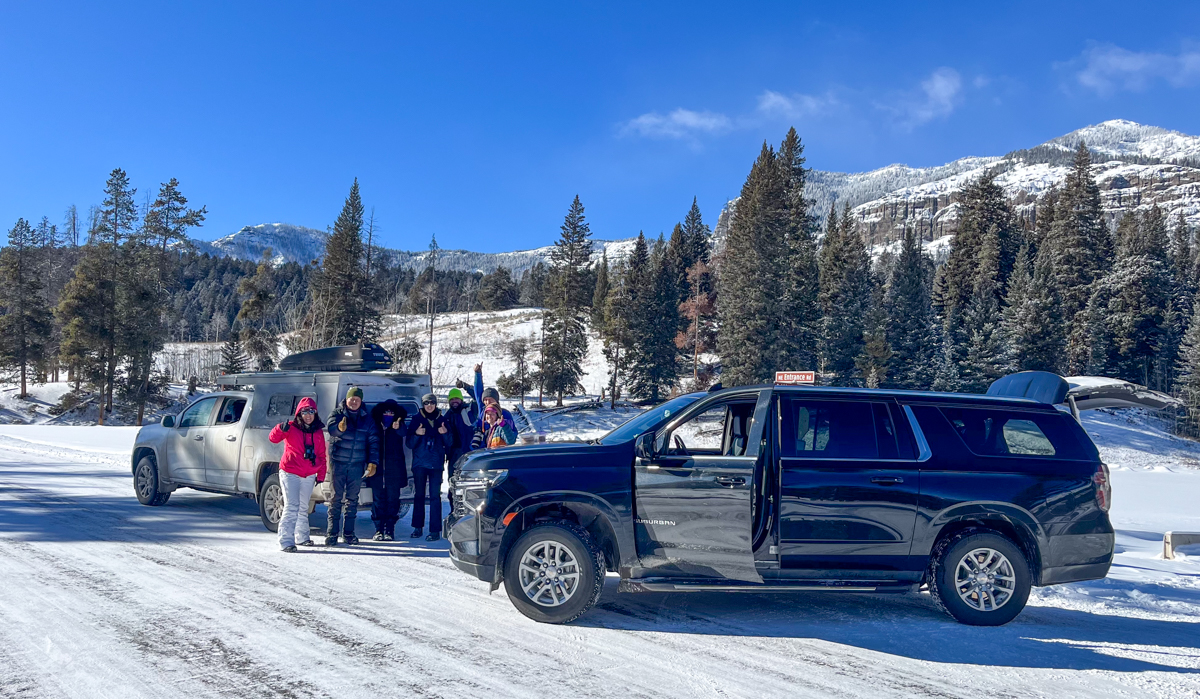For our last full day at Yellowstone we had two things on the docket: to go snowshoeing and to see our last ungulate, the mountain goat. We got into the park before sunrise making our way to a bison carcass we saw yesterday. While there, we watched 3 coyotes feeding on the bison (and later in the day we saw a wolf feeding on the same carcass). After that, we made two passes through the northeast corner of the park looking for mountain goats, but saw nothing.

Wolf at bison carcass
Our morning was freezing while checking things off our docket. It was -28°F as we were heading into the park, and the highest temperature we experienced today was -4°F. Throughout this “negative” day, we (unfortunately) had to use pit toilets. The toilet seat was so cold our infrared thermometer couldn’t even give us a reading on the temperature! Surprisingly, several of us mentioned how much warmer today’s temperatures felt. If you’d asked us before this trip, none of us would ever have thought -4°F was warm. However, when experiencing temperatures around -30°F, -4°F really does seem warm! This trip has taught us the importance of layers of clothing; we added and took away layers as we moved throughout the day and got in and out of cars.
We made one more pass through Lamar Valley to spot a mountain goat but came up unsuccessful yet again. With the weather in the negative teens all morning, when we stopped in Cooke City, MT to get coffee at Cooke City Coffee we were thrilled. After warming ourselves with a hot beverage, we continued our search for the elusive mountain goat. This next pass was not without issues. One of our SUVs discovered the importance of friction, when it slid on a patch of ice and got stuck in deep snow on the side of the road. No sooner had we gotten out of our vehicle to investigate when help arrived. This “help” just so happened to be Dr. John Winnie, ecology professor for Montana State University, in his truck with a tow strap! Within just a few minutes he was able to pull us out. We thanked him and offered him some baked goods (which he declined), and we exchanged information (never pass up the opportunity to network).

Before

After, with our new friend John
With our crisis averted, we moved on to our last snowshoe hike along the beautiful Pebble Creek. The trek was simple but the beauty was breathtaking. This area was devastated by the floods of 2022, and we saw evidence of this devastation on the landscape – downed trees, tangled picnic tables, and freshly eroded rocks. Our group observed canine and moose tracks along with an American dipper nest (see our earlier post for more on this amazing bird). Our group was blown away by the beauty, history and geology found within this small box canyon. While there, Klara shared a beautiful poem with our group. Everyone of our group members gained something different out of this snowshoe experience.
We ended our day in the park with one last look for a mountain goat, with no luck. We headed out of the park and made one last stop to take in a magical Yellowstone sunset!

Group on snowshoe hike
As we wrapped up our final group meeting, we realized we all managed to fulfill all the goals we set at the beginning of the trip from learning about geothermal features (Tracy) to experiencing moments of stillness (Sallie) to adopting a science point of view (Landon, our history teacher). The group shared their experiences and the many takeaways from our time in Yellowstone. We are pumped about meeting with the Yellowstone Geology Crew and an Education Ranger in the park tomorrow to further our knowledge and look for ways to bring this experience back to our students.
Our time in Yellowstone is almost up, but we all feel so thankful to have experienced this magical place with each other!

The poem Klara shared
